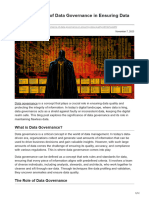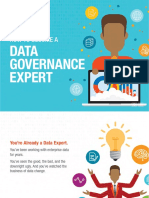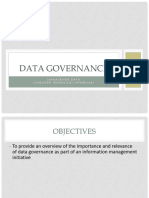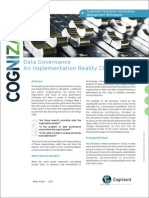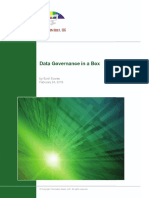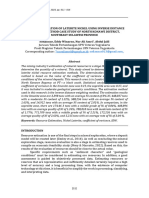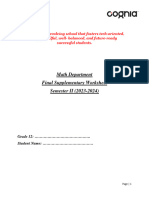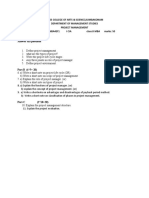Master Data Governance: Key Insights for Effective Implementation
In the ever-evolving landscape of data management, the spotlight is increasingly turning to the crucial
role of Data Governance (DG). Clients are seeking insights into what DG is, its benefits, and how to
effectively organize it.
The reality is, that without Data Governance, there is no Data Quality (DQ), it would not be possible to
keep everything in place and get to the desired level of DQ.
So, first, what are the key objective when it comes about Data Governance? We can look at them from
three angles:
1. People – basically this goes hand in hand with the operating model, and looks at Roles and
Responsibilities, what is the structure of the Data Governance Organization, training and
development of people, the adoption & socialization of the Data Governance
2. Process – this refers to developing the Processes, Policies, Standards, Metrics, Health Check
Controls in order to create, manage and govern the data. This must be done in line with the
Business Goals & Priorities
3. Technology – from a Data Governance perspective, this is how data is assessed, maintained,
migrated (if the case), monitored and reported
As mentioned above, DG is strongly related to DQ, hence the main achievements in implementing a
strong DG will translate into:
- Data Dictionary - Helps in defining, classifying and mapping the data and shows relationships
between other data elements
- Business Glossary - A Business Glossary defines terms across a business domain, providing a
source of truth for all business operations and database systems
- Data Decision Making – knowledge is power, and it helps in better business decision making
- Defining Roles And Responsibilities - Helps in defining roles and responsibilities to people in
accordance with data subjects
- Search All Metadata In One Common Area - Helps in achieving a common repository for entire
enterprise metadata
- Data Lineage - Helps in identifying the entire lifecycle of the data object along with
transformations and related IT systems
But DG is not a magic wand, but a structured approach involving standards, processes and policies /
procedures, basically the “how to” in terms of achieving and maintaining the DQ. Let’s see what these
are.
The policies establish accountability and sets standards that will need to be followed to be compliant
with the policy statements of criteria that are established by the organization to abide by laws and
regulations.
�The standards are sets of definitions that encourage consistent and desirable behaviors across the
organization. Data standards provide guidelines for ensuring consistency in the definition, usage and
management of data and serve as minimum documented requirements which must be met by data
users.
The processes / procedures define clear inputs and outputs to enable modular independence with
respect to other processes. Performance criteria for a process should be well-defined through metrics. A
well-formed procedure includes roles, responsibilities, controls, reporting metrics and templates.
All of the above should be applied across a DG Organization, that typically looks like in the diagram
below:
While having this structure, it must be tracked and monitored for effectiveness and correctness. This
involves using different metrics, which are essentially ways to measure how well things are going. Here
are some good practices when setting up these metrics:
Specific: The metrics should be focused on measuring a particular aspect or area
Measurable: It should be possible to collect meaningful data that is complete and accurate
Achievable: The performance targets set by these metrics should be realistic and doable for the
business
Relevant: Metrics should measure things that are crucial and directly impact how well the
business is performing
Timeless: Data should be available whenever it's needed to make business decisions promptly
So far, it sounds good, but in real life this ideal state is difficult to achieve, and usually just parts of the
entire DG framework are implemented. Consequently, companies often fall into one of the following
categories:
� Basic: Limited or no organization-wide Data Governance, lacking structured processes and
policies
Intermediate: A Design Council and Steering Committee may exist, but they are not very active
or fully engaged in governance efforts
Proficient: An Enterprise Governance team is in place, working towards institutionalizing a
comprehensive data strategy
Expert: The organization has reached a self-sustaining stage, requiring minimal intervention from
the Steering Committee, showcasing a high level of DG maturity
The following challenges should be overcome in order to get to the expert state:
Finding a Senior Business Sponsor: Securing a senior business figure willing to champion and
commit to DG is crucial
Political Will and Funding: Establishing support at the political level and securing adequate
funding are essential for the success of the DG initiative
Diverse Business Units: Overcoming challenges posed by diverse business units with varying
levels of enthusiasm, shared data sets, and project experiences
Varied Interest and Investment: Addressing the differing levels of interest, investment, and
maturity in data quality and governance across various business units
Scattered Data Management: Dealing with the diffusion of data management activities
throughout business units and IT, making centralization and consolidation difficult
Careful Scope Commitments: Making meticulous scope commitments, starting with lightweight
approaches, and gradually expanding to handle increasing data complexity cycles
Avoiding Unrealistic Scoping: Ensuring realistic scoping in terms of Data Domain, treating DG as a
program, and managing time and resource commitments effectively
We can see that the journey towards mastering Data Governance is a challenging one, filled with a lot of
nuances. Yet, the rewards are substantial—enhanced Data Quality, streamlined processes, and better
decision-making. As the data landscape continues to evolve and change, embracing a robust Data
Governance strategy is not just a necessity but a strategic imperative for organizations aiming to thrive in
the data-driven era.









